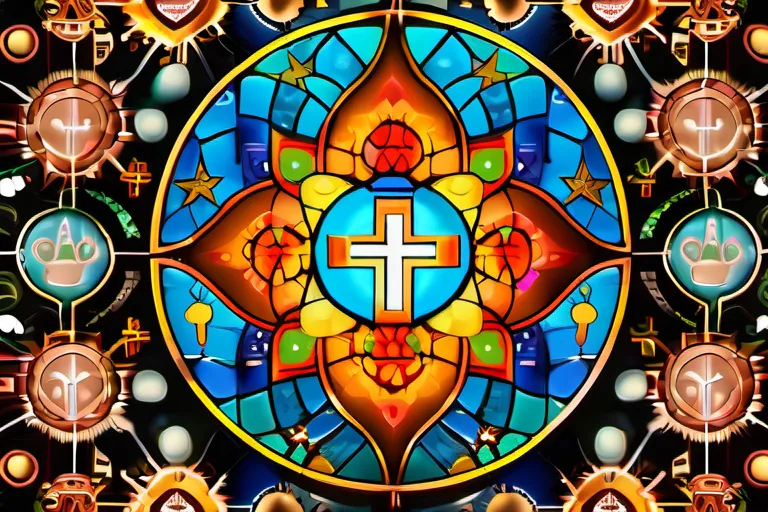Explore the origins, evolution, and diversity of religions across the globe.
Have you ever wondered why there are so many religions in the world? From Christianity to Islam, Hinduism, Buddhism, and beyond, this article delves into the fascinating history and development of various faiths.
The Origins of Religion
Why do humans seek out religion? Is it to find meaning, or simply a way to understand the world around us? The theories behind the origins of religion are as varied and complex as religions themselves. One prominent theory is the social contract perspective, which suggests that people came together in groups for mutual protection and cooperation, leading naturally to the development of religious beliefs as a unifying force.
But what about those who believe in the evolutionary approach? This idea posits that religion evolved from simpler spiritual practices into more complex belief systems. It’s like how a caterpillar transforms into a butterfly; just with humans and their belief in gods or higher powers. How did this transformation happen, and why?
Consider the cognitive development theory, which suggests that early humans needed explanations for natural phenomena to feel secure. Imagine our ancestors living in fear of thunderstorms or eclipses – wouldn’t it be comforting to believe these were controlled by gods? It’s like having a storybook that helps children understand their world; religion might have served a similar purpose for adults.
Then there are the sociological theories, which look at how societies form around shared beliefs. How do we explain why so many religions emerged in different parts of the world simultaneously? Is it coincidence, or is there something inherent in human society that naturally leads to religious practices?
As we explore these theories, we see religion as a dynamic, ever-evolving concept. It’s like a tree with many branches – each branch representing a unique path of belief and practice. The social contract, cognitive development, and evolutionary perspectives all offer different lenses through which we can understand the diversity of religions across our world.
By delving into these theories, we gain insights not just about religion but also about human nature itself. How do these beliefs shape societies? What role do they play in our daily lives? Understanding the origins and evolution of religions helps us appreciate their complexity and richness – truly a reflection of the diverse tapestry that is humanity.
Religious Evolution: From Ancient to Modern Times
From the ancient cradles of civilization to the modern global landscape, religions have evolved through time, much like rivers shaping landscapes over millennia. Imagine these faiths as living organisms, growing and adapting in response to their environments—social, cultural, political, and natural.
Religion in Ancient Times: The earliest forms of religion were deeply intertwined with nature, agriculture, and the cycles of life itself. Think of ancient Egypt where the Nile River was a symbol of creation and rebirth, or Greece where gods and goddesses personified natural elements like fire, air, water, and earth.
Then came major turning points: the birth of Zoroastrianism in Persia around 1000 BCE, which introduced the concept of a single, all-powerful deity. Contrast this with the rise of Hinduism in India, where the divine was seen in myriad forms—around 2000 years later.
The Golden Age of Religions: By the first millennium CE, we see religions flourishing in their unique ways. Consider Christianity, born amid the Roman Empire, which spread through trade routes and missionary work. Meanwhile, Islam emerged from the Arabian Peninsula around 610 CE, rapidly expanding its influence across North Africa, Europe, and Asia.
The Medieval and Renaissance Eras: During these periods, religious thought became more refined and complex. In Europe, the Middle Ages saw intense theological debates, leading to the Protestant Reformation in the 16th century by figures like Martin Luther. This shift questioned many aspects of traditional church doctrine, sparking new interpretations.
By the time we reach the modern era, religions have not only expanded geographically but also philosophically. Think about the rise of liberal theology or secular humanism, which challenge long-held beliefs and practices in religious institutions.
In conclusion, religion’s journey from ancient roots to modern times is a testament to its adaptability and resilience. Each step along this path has left an indelible mark on human history, shaping societies and individuals in profound ways. As we look at the spread of religions across continents in our next chapter, remember how each faith carries within it stories of hope, struggle, and transformation.
The Spread of Religions Across the World
The spread of religions across continents is like a vast, interconnected web, woven through the threads of trade, conquest, and migration. Imagine each religion as a seed carried by travelers, soldiers, and merchants from one land to another. These seeds were often dispersed without much intention but grew into sprawling gardens, altering the landscapes of entire regions.
Consider Buddhism’s journey from its birthplace in ancient India. As trade routes flourished along the Silk Road, Buddhist monks traveled far and wide, spreading their teachings as they went. It’s a bit like how a river carves through rock over time; the gentle flow of dialogue, education, and cultural exchange gradually transformed societies.
Similarly, Christianity spread from its roots in the Middle East to Europe and beyond. The Roman Empire’s conquests played a crucial role, much like how bees pollinate flowers, spreading not just military might but also religious beliefs. As empires crumbled, new ones rose, carrying their faiths with them.
Muslims too embarked on their own journeys of exploration and conquest, establishing vast empires that spanned across North Africa, the Middle East, and into Spain. It’s as if they were the wind, dispersing seeds far from their origin. Each stop along the way saw these teachings adapt and evolve, like a flower blooming in different soils.
The diversity of religions we see today is a testament to this global exchange. Religions have not only spread but also mixed, creating unique hybrid forms that reflect the multicultural tapestry of our world. Just as a garden thrives when it embraces its diversity, humanity’s spiritual landscape benefits from the varied paths people follow.
So, next time you think about the world’s religions, remember them as stories of human connection and transformation, carried across continents by the very fabric of history itself.
Religious Diversity in Different Regions
Imagine wandering through the ancient streets of Europe, where the echoes of churches and cathedrals mingle with the whispers of mosques and synagogues. How did these diverse religious landscapes come to be? In Europe, Christianity has long been a dominant force, but its path was not always straightforward. From the early spread of Christianity after Jesus’s time to the formation of various denominations like Catholicism, Protestantism, and Orthodoxy, each region adopted its own unique flavor. Is it any wonder that the Roman Empire, with its vast territories, played such a crucial role in spreading Christianity?
Now, turn your gaze eastward to Asia, where religions like Hinduism, Buddhism, Islam, and Taoism have woven their complex histories across diverse landscapes. In India, Hinduism’s intricate tapestry of gods and goddesses speaks of ancient traditions and spiritual evolution. Buddhism, originating from the teachings of Siddhartha Gautama, spread along trade routes, transforming societies far beyond its birthplace in present-day Nepal and India.
Travel further to Africa, where religions like Islam, Christianity, traditional African beliefs, and syncretic practices coexist, reflecting the continent’s rich cultural diversity. The transatlantic slave trade brought Africans to the Americas, introducing new religious landscapes that blended with indigenous beliefs and European influences. How did these complex mixtures of faiths shape the spiritual identities of those societies?
In the Americas, Native American religions, Christianity, Judaism, Islam, and a variety of immigrant traditions have interwoven into a vibrant religious mosaic. The arrival of Spanish conquistadors brought Catholicism to South America, while Protestant missionaries in North America shaped much of its religious landscape. Today, these regions continue to evolve, with new movements and beliefs emerging from the rich tapestry of their past.
Each region’s religious diversity is a reflection of human history and culture—each belief system a unique lens through which we see the world. How do you think this diversity enriches our global community?
The Role of Religion in Society
The role of religion in society cannot be overstated; it has been the heart and soul of human culture, politics, and daily life for centuries. How many times have we pondered over the question: how would societies function without the deep-seated beliefs that religions provide? Imagine a world where every individual’s values were solely shaped by personal experience or logic alone – what kind of society would emerge from such an environment?
Religion has long been intertwined with governance and social order, often serving as a unifying force. It influences laws, customs, and even the architectural landscape of cities. Take, for instance, how Islamic architecture in places like Morocco or Spain reflects not just aesthetic preferences but also religious values and practices. Similarly, the Christian Church’s influence on Western European history is evident in countless cathedrals that stand as testaments to its power and reach.
But religion’s role extends beyond physical structures. It shapes societal norms and behaviors at a deeply personal level. Think about it: how many of your daily decisions are influenced by religious teachings or ethical guidelines? Whether it’s the way you treat others, the holidays you celebrate, or even dietary choices, religions often provide a moral compass that guides our actions.
Moreover, religion plays a significant role in political spheres. In many regions, political leaders and policies can be heavily influenced by religious ideologies. The tension between secularism and religious influence continues to shape global politics today. For instance, the debate over abortion rights or LGBTQ+ rights often hinges on deeply held religious beliefs.
However, religion’s impact is not always positive; it has also been a source of conflict throughout history. Wars, persecution, and intolerance have often stemmed from religious differences. Yet, we must remember that these instances are not the norm. The vast majority of people practice their faiths peacefully and with respect for others.
As we delve into the complex role religion plays in society, it becomes clear that its influence is multifaceted and essential. Understanding this role helps us navigate a world where diversity in religious beliefs is increasingly common. In the next chapter, we will explore how different faiths coexist or clash with each other, facing challenges and finding opportunities for peace.
Religious Pluralism: Coexistence and Conflict
Imagine the world as a vast garden, where each flower represents a different religion. Some are vibrant and bold, while others are delicate and subtle. How do these diverse flowers coexist in this global garden? Can they bloom together in harmony, or does the competition for sunlight and space lead to conflict?
“How can we understand religious pluralism if we fail to see each religion as a unique voice in the symphony of humanity?”
The concept of religious pluralism involves the coexistence of multiple religions within a society, often challenging traditional notions of exclusivity and supremacy. In this global garden, the challenge lies not only in recognizing these different voices but also in fostering an environment where they can thrive side by side.
-
Consider the example of India, where Hinduism, Islam, Christianity, Sikhism, and many others coexist. The interplay between these faiths has led to both conflict and mutual respect, highlighting the complexity of religious pluralism.
-
In contrast, look at countries like Israel or Northern Ireland, where religious differences have fueled long-standing conflicts. Here, the question isn’t just about coexistence but also about finding a path towards reconciliation.
The key to navigating these complexities lies in education and dialogue. By understanding the roots and evolution of each religion—how they emerged, changed over time, and interacted with one another—we can better appreciate their unique perspectives and the challenges they pose.
“Is it not true that every religion has its own narrative, its own tale to tell? Can we learn from these tales without imposing our own beliefs?”
Religious pluralism presents both opportunities and challenges. On one hand, it enriches our cultural landscape by offering diverse viewpoints and moral frameworks. On the other, it requires us to address deep-seated issues of identity, power, and justice.
The journey towards a more inclusive society is ongoing. It involves acknowledging the historical context of each religion, fostering open-mindedness, and working towards policies that respect the rights and freedoms of all individuals, regardless of their faith.
Conclusion
 By understanding the unique origins and evolution of each religion, we gain a deeper appreciation for the rich tapestry of beliefs that make up our world today.
By understanding the unique origins and evolution of each religion, we gain a deeper appreciation for the rich tapestry of beliefs that make up our world today.











